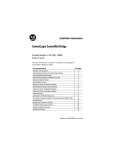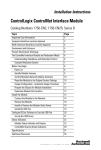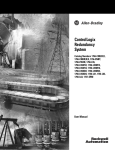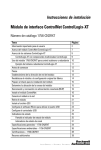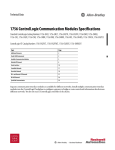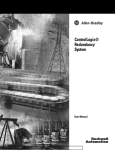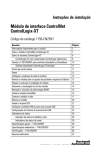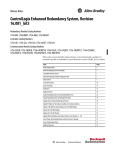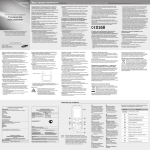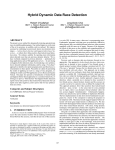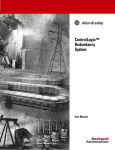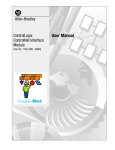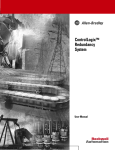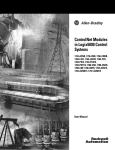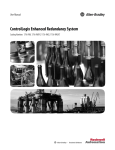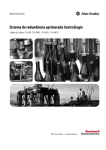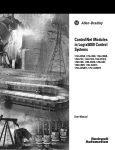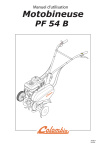Download CNET-IN005 - Rockwell Automation
Transcript
Installation Instructions ControlNet Modules Catalog Numbers 1756-CN2, 1756-CN2R, 1756-CN2RK, 1756-CN2RXT, 1756-CNB, 1756-CNBR, 1768-CNB, 1768-CNBR Important User Information Read this document and the documents listed in the additional resources section about installation, configuration, and operation of this equipment before you install, configure, operate, or maintain this product. Users are required to familiarize themselves with installation and wiring instructions in addition to requirements of all applicable codes, laws, and standards. Activities including installation, adjustments, putting into service, use, assembly, disassembly, and maintenance are required to be carried out by suitably trained personnel in accordance with applicable code of practice. If this equipment is used in a manner not specified by the manufacturer, the protection provided by the equipment may be impaired. In no event will Rockwell Automation, Inc. be responsible or liable for indirect or consequential damages resulting from the use or application of this equipment. The examples and diagrams in this manual are included solely for illustrative purposes. Because of the many variables and requirements associated with any particular installation, Rockwell Automation, Inc. cannot assume responsibility or liability for actual use based on the examples and diagrams. No patent liability is assumed by Rockwell Automation, Inc. with respect to use of information, circuits, equipment, or software described in this manual. Reproduction of the contents of this manual, in whole or in part, without written permission of Rockwell Automation, Inc., is prohibited. Throughout this manual, when necessary, we use notes to make you aware of safety considerations. WARNING: Identifies information about practices or circumstances that can cause an explosion in a hazardous environment, which may lead to personal injury or death, property damage, or economic loss. ATTENTION: Identifies information about practices or circumstances that can lead to personal injury or death, property damage, or economic loss. Attentions help you identify a hazard, avoid a hazard, and recognize the consequence. IMPORTANT Identifies information that is critical for successful application and understanding of the product. Labels may also be on or inside the equipment to provide specific precautions. SHOCK HAZARD: Labels may be on or inside the equipment, for example, a drive or motor, to alert people that dangerous voltage may be present. BURN HAZARD: Labels may be on or inside the equipment, for example, a drive or motor, to alert people that surfaces may reach dangerous temperatures. ARC FLASH HAZARD: Labels may be on or inside the equipment, for example, a motor control center, to alert people to potential Arc Flash. Arc Flash will cause severe injury or death. Wear proper Personal Protective Equipment (PPE). Follow ALL Regulatory requirements for safe work practices and for Personal Protective Equipment (PPE). Allen-Bradley, CompactLogix, CompactLogix-XT, ControlFLASH, ControlLogix-XT, ControlLogix, FLEX I/O-XT, Logix5000, Logix-XT, RSLinx, RSLogix, RSNetWorx, Rockwell Software, Rockwell Automation, RSLogix 5000, RSLinx Classic, RSNetWorx for ControlNet, and Studio 5000 are trademarks of Rockwell Automation, Inc. Trademarks not belonging to Rockwell Automation are property of their respective companies. Summary of Changes This manual contains new and updated information. Changes throughout this revision are marked by change bars, as shown to the right of this paragraph. New and Updated Information This table contains the changes made to this revision. Topic Page Updated artwork to illustrate module redesign Throughout document Updated EDS file and firmware download procedures Chapters 1, 2, and 3 Updated 1756 status indicators Appendix A Rockwell Automation Publication CNET-IN005C-EN-P - July 2014 3 Summary of Changes Notes: 4 Rockwell Automation Publication CNET-IN005C-EN-P - July 2014 Table of Contents Preface Studio 5000 Environment . . . . . . . . . . . . . . . . . . . . . . . . . . . . . . . . . . . . . . . . . . 7 Additional Resources . . . . . . . . . . . . . . . . . . . . . . . . . . . . . . . . . . . . . . . . . . . . . . . 8 Chapter 1 Install a 1756 ControlNet Communication Module ControlLogix-XT Systems . . . . . . . . . . . . . . . . . . . . . . . . . . . . . . . . . . . . . . . . ControlLogix-XT with Traditional ControlLogix Components. . Redundant Media . . . . . . . . . . . . . . . . . . . . . . . . . . . . . . . . . . . . . . . . . . . . . . . . Installation Summary. . . . . . . . . . . . . . . . . . . . . . . . . . . . . . . . . . . . . . . . . . . . . Determine Module Slot Location. . . . . . . . . . . . . . . . . . . . . . . . . . . . . . . . . . Set the Node Address. . . . . . . . . . . . . . . . . . . . . . . . . . . . . . . . . . . . . . . . . . . . . Install the Module. . . . . . . . . . . . . . . . . . . . . . . . . . . . . . . . . . . . . . . . . . . . . . . . Connect the Module to a ControlNet Network . . . . . . . . . . . . . . . . . . . . Remove the Module . . . . . . . . . . . . . . . . . . . . . . . . . . . . . . . . . . . . . . . . . . . . . . Reset the Module to the Original Factory Settings. . . . . . . . . . . . . . . Keeper Configuration—Automatic Keeper Crossload . . . . . . . . . . . Install the EDS File and Get Firmware Updates. . . . . . . . . . . . . . . . . . . . . Download the Firmware . . . . . . . . . . . . . . . . . . . . . . . . . . . . . . . . . . . . . . Connect a Programming Terminal to the Network with a 1786-CP Cable . . . . . . . . . . . . . . . . . . . . . . . . . . . . . . . . . . . . . . . . . . Connect to the Module via the USB Port . . . . . . . . . . . . . . . . . . . . . . . . . . 11 11 12 12 12 13 14 15 17 18 18 19 19 20 21 Chapter 2 Install a 1768 ControlNet Communication Module Redundant Media . . . . . . . . . . . . . . . . . . . . . . . . . . . . . . . . . . . . . . . . . . . . . . . . Installation Summary. . . . . . . . . . . . . . . . . . . . . . . . . . . . . . . . . . . . . . . . . . . . . Grounding Considerations . . . . . . . . . . . . . . . . . . . . . . . . . . . . . . . . . . . . Set the Node Address. . . . . . . . . . . . . . . . . . . . . . . . . . . . . . . . . . . . . . . . . . . . . Install the Module. . . . . . . . . . . . . . . . . . . . . . . . . . . . . . . . . . . . . . . . . . . . . . . . If You Use Screws to Mount the Module . . . . . . . . . . . . . . . . . . . . . . . Mount on a DIN Rail. . . . . . . . . . . . . . . . . . . . . . . . . . . . . . . . . . . . . . . . . Connect the Module to a ControlNet Network . . . . . . . . . . . . . . . . . . . . Remove the Module . . . . . . . . . . . . . . . . . . . . . . . . . . . . . . . . . . . . . . . . . . . . . . Install the EDS File and Get Firmware Updates. . . . . . . . . . . . . . . . . . . . . Download the Firmware . . . . . . . . . . . . . . . . . . . . . . . . . . . . . . . . . . . . . . 25 25 25 25 26 26 27 28 29 31 31 Chapter 3 Redundant Media Use Redundant Media . . . . . . . . . . . . . . . . . . . . . . . . . . . . . . . . . . . . . . . . . . . 33 Additional Resources . . . . . . . . . . . . . . . . . . . . . . . . . . . . . . . . . . . . . . . . . 35 Rockwell Automation Publication CNET-IN005C-EN-P - July 2014 5 Table of Contents Appendix A 1756 ControlNet Status Indicators Status Indicators. . . . . . . . . . . . . . . . . . . . . . . . . . . . . . . . . . . . . . . . . . . . . . Interpret the OK Status Indicator . . . . . . . . . . . . . . . . . . . . . . . . . . . . . . Interpret the Network Channel Status Indicators . . . . . . . . . . . . . . . 1756-CN2, 1756-CN2R, 1756-CN2RXT, and 1756-CN2RK ControlNet Communication Modules. . . . . . . . . . . . . . . OK Status Indicator and Display. . . . . . . . . . . . . . . . . . . . . . . . . . . . . . . Network Channel Status Indicators . . . . . . . . . . . . . . . . . . . . . . . . . . . . 1756-CNB/E and 1756-CNBR/E ControlNet Communication Modules . . . . . . . . . . . . . . OK Status Indicator and Display. . . . . . . . . . . . . . . . . . . . . . . . . . . . . . . Network Channel Status Indicators . . . . . . . . . . . . . . . . . . . . . . . . . . . . 37 38 38 38 39 42 43 43 46 Appendix B USB Communication Set Up a USB Driver . . . . . . . . . . . . . . . . . . . . . . . . . . . . . . . . . . . . . . . . . . . . . 47 Appendix C 1768 ControlNet Module Status Indicators 1768-CNB and 1768-CNBR ControlNet Modules . . . . . . . . . . . . . . . . . 51 OK Status Indicator and Display. . . . . . . . . . . . . . . . . . . . . . . . . . . . . . . 52 Network Channel Status Indicators . . . . . . . . . . . . . . . . . . . . . . . . . . . . 53 Index 6 Rockwell Automation Publication CNET-IN005C-EN-P - July 2014 Preface This manual describes how to install and start up ControlNet modules with Logix5000 ™ controllers. You should use this manual if you program applications that use the ControlNet network with one of these Logix5000 controllers: • CompactLogix™ • ControlLogix® You should also understand the following: • Networking concepts • How to the use Studio 5000™ environment • How to use RSLinx® Classic programming software Studio 5000 Environment The Studio 5000 Automation Engineering and Design Environment combines engineering and design elements into a common environment. The first element in the Studio 5000 environment is the Logix Designer application. The Studio 5000 Logix Designer application is the rebranding of RSLogix™ 5000 software and continues to be the product to program Logix5000 controllers for discrete, process, batch, motion, safety, and drive-based solutions. The Studio 5000 environment is the foundation for the future of Rockwell Automation engineering design tools and capabilities. This environment is the one place for design engineers to develop all of the elements of their control system. Rockwell Automation Publication CNET-IN005C-EN-P - July 2014 7 Preface Additional Resources These documents contain additional information concerning related products from Rockwell Automation. Resource Description ControlNet Network Configuration User Manual, publication CNET-UM001 Provides details about how to use ControlNet communication modules with Logix5000 controllers and communicate with other devices on the ControlNet network. ControlNet Coax Media Planning and Installation Guide, publication CNET-IN002 Describes the required components of a ControlNet coax media system. ControlNet Standard and High-flex Coax Cable Installation Instructions, publication 1786-IN009 Provides application information you need to consider when you install standard RG-6 (catalog number 1786-RG6/A) and high-flex RG-6 (catalog number 1786-RG6F/A) coax cable in your ControlNet network. Industrial Automation Wiring and Grounding Guidelines, publication 1770-4.1 Provides general guidelines for installing a Rockwell Automation industrial system. Product Certifications website, http://www.ab.com Provides declarations of conformity, certificates, and other certification details. You can view or download publications at http:/www.rockwellautomation.com/literature/. To order paper copies of technical documentation, contact your local Allen-Bradley distributor or Rockwell Automation sales representative. 8 Rockwell Automation Publication CNET-IN005C-EN-P - July 2014 Chapter 1 Install a 1756 ControlNet Communication Module Topic Page ControlLogix-XT Systems 11 Redundant Media 12 Installation Summary 12 Determine Module Slot Location 12 Set the Node Address 13 Install the Module 14 Connect the Module to a ControlNet Network 15 Remove the Module 17 Install the EDS File and Get Firmware Updates 19 Connect a Programming Terminal to the Network with a 1786-CP Cable 20 Connect to the Module via the USB Port 21 ATTENTION: Environment and Enclosure This equipment is intended for use in a Pollution Degree 2 industrial environment, in overvoltage Category II applications (as defined in IEC 60664-1), at altitudes up to 2000 m (6562 ft) without derating. This equipment is not intended for use in residential environments and may not provide adequate protection to radio communication services in such environments. This equipment is supplied as open-type equipment. It must be mounted within an enclosure that is suitably designed for those specific environmental conditions that will be present and appropriately designed to prevent personal injury resulting from accessibility to live parts. The enclosure must have suitable flame-retardant properties to prevent or minimize the spread of flame, complying with a flame spread rating of 5VA or be approved for the application if nonmetallic. The interior of the enclosure must be accessible only by the use of a tool. Subsequent sections of this publication may contain additional information regarding specific enclosure type ratings that are required to comply with certain product safety certifications. In addition to this publication, see the following: • Industrial Automation Wiring and Grounding Guidelines, publication 1770-4.1, for additional installation requirements. • NEMA Standard 250 and IEC 60529, as applicable, for explanations of the degrees of protection provided by enclosures. Rockwell Automation Publication CNET-IN005C-EN-P - July 2014 9 Chapter 1 Install a 1756 ControlNet Communication Module North American Hazardous Location Approval The following information applies when operating this equipment in hazardous locations. Informations sur l’utilisation de cet équipement en environnements dangereux. Products marked "CL I, DIV 2, GP A, B, C, D" are suitable for use in Class I Division 2 Groups A, B, C, D, Hazardous Locations and nonhazardous locations only. Each product is supplied with markings on the rating nameplate indicating the hazardous location temperature code. When combining products within a system, the most adverse temperature code (lowest "T" number) may be used to help determine the overall temperature code of the system. Combinations of equipment in your system are subject to investigation by the local Authority Having Jurisdiction at the time of installation. Les produits marqués "CL I, DIV 2, GP A, B, C, D" ne conviennent qu'à une utilisation en environnements de Classe I Division 2 Groupes A, B, C, D dangereux et non dangereux. Chaque produit est livré avec des marquages sur sa plaque d'identification qui indiquent le code de température pour les environnements dangereux. Lorsque plusieurs produits sont combinés dans un système, le code de température le plus défavorable (code de température le plus faible) peut être utilisé pour déterminer le code de température global du système. Les combinaisons d'équipements dans le système sont sujettes à inspection par les autorités locales qualifiées au moment de l'installation. WARNING: EXPLOSION HAZARD • Do not disconnect equipment unless power has been removed or the area is known to be nonhazardous. • Do not disconnect connections to this equipment unless power has been removed or the area is known to be nonhazardous. Secure any external connections that mate to this equipment by using screws, sliding latches, threaded connectors, or other means provided with this product. • Substitution of components may impair suitability for Class I, Division 2. • If this product contains batteries, they must only be changed in an area known to be nonhazardous. WARNING: RISQUE D’EXPLOSION • Couper le courant ou s'assurer que l'environnement est classé non dangereux avant de débrancher l'équipement. • Couper le courant ou s'assurer que l'environnement est classé non dangereux avant de débrancher les connecteurs. Fixer tous les connecteurs externes reliés à cet équipement à l'aide de vis, loquets coulissants, connecteurs filetés ou autres moyens fournis avec ce produit. • La substitution de composants peut rendre cet équipement inadapté à une utilisation en environnement de Classe I, Division 2. • S'assurer que l'environnement est classé non dangereux avant de changer les piles. European Hazardous Location Approval The following applies when the product bears the Ex Marking. This equipment is intended for use in potentially explosive atmospheres as defined by European Union Directive 94/9/EC and has been found to comply with the Essential Health and Safety Requirements relating to the design and construction of Category 3 equipment intended for use in Zone 2 potentially explosive atmospheres, given in Annex II to this Directive. Compliance with the Essential Health and Safety Requirements has been assured by compliance with EN 60079-15 and EN 60079-0. WARNING: • This equipment must be installed in an enclosure providing at least IP54 protection when applied in Zone 2 environments. • This equipment shall be used within its specified ratings defined by Rockwell Automation. • Provision shall be made to prevent the rated voltage from being exceeded by transient disturbances of more than 40% when applied in Zone 2 environments. • This equipment must be used only with ATEX certified Rockwell Automation backplanes. • Secure any external connections that mate to this equipment by using screws, sliding latches, threaded connectors, or other means provided with this product. • Do not disconnect equipment unless power has been removed or the area is known to be nonhazardous. ATTENTION: This equipment is not resistant to sunlight or other sources of UV radiation. 10 Rockwell Automation Publication CNET-IN005C-EN-P - July 2014 Install a 1756 ControlNet Communication Module Chapter 1 ATTENTION: Prevent Electrostatic Discharge This equipment is sensitive to electrostatic discharge, which can cause internal damage and affect normal operation. Follow these guidelines when you handle this equipment: • Touch a grounded object to discharge potential static. • Wear an approved grounding wriststrap. • Do not touch connectors or pins on component boards. • Do not touch circuit components inside the equipment. • Use a static-safe workstation, if available. • Store the equipment in appropriate static-safe packaging when not in use. ATTENTION: Personnel responsible for the application of safety-related programmable electronic systems (PES) shall be aware of the safety requirements in the application of the system and shall be trained in using the system. ControlLogix-XT Systems The ControlLogix-XT™ products include control and communication system components that, when used with FLEX I/O-XT™ products, provide a complete control system solution that can be used in environments where temperatures range from -20…70 °C (-4…158 °F). When used independently, the ControlLogix-XT system can withstand environments where the temperature ranges from -25…70 °C (-13…158 °F). ControlLogix-XT with Traditional ControlLogix Components IMPORTANT ControlLogix-XT system components are rated for extreme environmental conditions only when used properly with other LogixXT system components. The use of ControlLogix-XT components with traditional ControlLogix system components nullifies extreme-environment ratings. If a ControlLogix-XT module is used with traditional ControlLogix products that are not designed for extreme environments, the ControlLogix-XT module can withstand only the environments specified for the traditional ControlLogix version of the module. For example, if a 1756-CN2RXT module is used in a traditional 1756-A10 chassis, the 1756-CN2RXT module can withstand only the environment specified for the traditional 1756-CN2R module. The ControlLogix-XT system components are designed to meet the same and greater operational and environmental requirements as traditional ControlLogix products. When a ControlLogix-XT component is used as a replacement for a traditional ControlLogix component, the functional and environmental requirements of the traditional ControlLogix component apply. Rockwell Automation Publication CNET-IN005C-EN-P - July 2014 11 Chapter 1 Install a 1756 ControlNet Communication Module Redundant Media These 1756 ControlNet bridge modules have two ControlNet ports to support redundant media: • 1756-CN2R • 1756-CNBR • 1756-CN2R • 1756-CN2RXT • 1756-CN2RK For information about using these modules with redundant media, see Redundant Media on page 33. Installation Summary To install a communication module in a 1756 ControlLogix chassis, complete these steps. 1. Determine Module Slot Location. 2. Set the Node Address. 3. Install the Module. 4. Connect the Module to a ControlNet Network. 5. Remove the Module. 6. Install the EDS File and Get Firmware Updates. 7. Connect a Programming Terminal to the Network with a 1786-CP Cable. 8. Connect to the Module via the USB Port. Determine Module Slot Location Install the communication module in any slot in the ControlLogix chassis. You can install multiple communication modules in the same chassis. This example shows chassis slot numbering in a 4-slot chassis. Slot 0 is the first slot and is always the leftmost slot in the rack. 3 4 5 6 1 2 20806 12 Rockwell Automation Publication CNET-IN005C-EN-P - July 2014 Item Description 1 Power supply 2 Chassis 3 Slot 0 4 Slot 1 5 Slot 2 6 Slot 3 Install a 1756 ControlNet Communication Module Chapter 1 This example shows chassis slot numbering in a ControlLogix-XT chassis. Slot 0 Slot 2 Slot 1 Use a small screwdriver to set the module’s node address switches. You must specify a unique ControlNet node address. You can select an address of 01…99. Address 00 is an invalid ControlNet node address. Side of Module Front of Module Set the Node Address Slot 4 Slot 3 This module’s node address is 23 Rockwell Automation Publication CNET-IN005C-EN-P - July 2014 32462-M 13 Chapter 1 Install a 1756 ControlNet Communication Module Install the Module WARNING: When you insert or remove the module while backplane power is on, an electrical arc can occur. This could cause an explosion in hazardous location installations. Be sure that power is removed or the area is nonhazardous before proceeding. Repeated electrical arcing causes excessive wear to contacts on both the module and its mating connector. Worn contacts may create electrical resistance that can affect module operation. To install the module, follow this procedure. 1. Align the circuit board with the top and bottom guides in the chassis. 2. Slide the module into the chassis making sure the module backplane connector properly connects to the chassis backplane. The module is properly installed when it is flush with the power supply or other installed modules. Circuit Board 32463-M ATTENTION: Do not force the module into the backplane connector. If you cannot seat the module with firm pressure, check the alignment. Forcing the module into the chassis can damage the backplane connector or the module. 14 Rockwell Automation Publication CNET-IN005C-EN-P - July 2014 Install a 1756 ControlNet Communication Module Connect the Module to a ControlNet Network Chapter 1 You can connect the module to the ControlNet network by using a tap, catalog numbers 1786-TPR, 1786-TPS, 1786-TPYR, 1786-TPYS, or 1786-TCT2BD1. WARNING: If you connect or disconnect the communication cable with power applied to this module or any device on the network, an electrical arc can occur. This could cause an explosion in hazardous location installations. Be sure that power is removed or the area is nonhazardous before proceeding. WARNING: Do not use the USB port in hazardous locations. ATTENTION: The USB port is intended only for temporary local programming purposes and is not intended for permanent connection. The USB cable is not to exceed 3.0 m (9.84 ft) and must not contain hubs. This example shows a ControlNet network using redundant media. 1756-CN2R Module in a 1756-A4 Chassis ControlNet Node ControlNet Link Redundant Media (Optional) ControlNet Node TIP For network connections, we recommend taps with a straight connector (catalog number 1786-TPS or 1786-TPYS) because of the location of the BNC connectors on the bottom of the module. Rockwell Automation Publication CNET-IN005C-EN-P - July 2014 15 Chapter 1 Install a 1756 ControlNet Communication Module To connect the module to the network with a tap, perform this procedure. 1. Remove and save the dust caps from the ControlNet taps. ATTENTION: Do not allow any metal portions of the tap to contact any conductive material. If you disconnect the tap from the module, place the dust cap back on the straight or right-angle connector to prevent the connector from accidentally contacting a metallic grounded surface. Trunkline A Trunkline B 1756-CN2 Trunkline A 1756-CN2R Trunklines A and B Dust Cap Dust Cap 2. Connect the tap’s straight or right-angle connector to the module’s BNC connector. If your network supports Then connect the tap’s connector Nonredundant media (all 1756-CNx modules) From trunkline A to channel A on the module. Redundant media (1756-CNBR, 1756-CN2R, 1756-CN2RXT, and 1756-CN2RK modules) From trunkline A to channel A on the 1756-CN2R module. From trunkline B to channel B on the 1756-CN2R module. IMPORTANT To avoid accidentally reversing the tap connections, before making your connection, check the tap drop cable for the label indicating the attached segment. Accidental connection reversals produce incorrect status displays and require troubleshooting. Redundant Media Nonredundant Media Network Network Tap Tap Tap 32464 3. Apply power to the module and check the status indicators to determine whether the power supply and module are operating properly. For more information about status indicators, see 1756 ControlNet Status Indicators on page 37. 16 Rockwell Automation Publication CNET-IN005C-EN-P - July 2014 Install a 1756 ControlNet Communication Module Remove the Module Chapter 1 You can install or remove this module while chassis power is applied. WARNING: When you insert or remove the module while backplane power is on, an electrical arc can occur. This could cause an explosion in hazardous location installations. Be sure that power is removed or the area is nonhazardous before proceeding. Repeated electrical arcing causes excessive wear to contacts on both the module and its mating connector. Worn contacts may create electrical resistance that can affect module operation. To remove or replace the module, use this procedure. 1. Push on the upper and lower module tabs to disengage them. 2. Slide the module out of chassis. The figure shows the removal of a 1756-CN2RXT module. X T Rockwell Automation Publication CNET-IN005C-EN-P - July 2014 17 Chapter 1 Install a 1756 ControlNet Communication Module Reset the Module to the Original Factory Settings If you are using a 1756-CN2, 1756-CN2R, 1756-CN2RXT or 1756-CN2RK communication module, you can reset the module to its original settings and clear all keeper information. To reset a module to its factory settings, complete these steps. 1. Remove power from the chassis. IMPORTANT Removing power from the chassis before removing the module is only necessary if the module is in a Class I, Division 2 hazardous location. 2. Remove the module from the chassis. 3. Reset the switches to 00. IMPORTANT Do not use the 00 switch setting during normal module operation. 4. Replace the module in the chassis. 5. Apply power to the chassis. 6. After the module status display reads ‘Reset Complete—Change Switch Settings’, remove power from the chassis. 7. Remove the module from the chassis. 8. Set the switches to their final value. 9. Replace the module in the chassis. 10. Apply power to the chassis. Keeper Configuration—Automatic Keeper Crossload The 1756-CN2, 1756-CN2R, 1756-CN2RXT, and 1756-CN2RK communication modules are keeper capable modules. If a keeper capable module has a valid configuration and has the lowest address among the keeper capable nodes on the network, it becomes the active keeper. The active keeper is the node that distributes network configuration information to other nodes as the network is formed or as nodes are added to the network. When the module is first removed from the box or is reset to the original factory settings, it will automatically attempt to crossload configuration information from the current active keeper. If an active keeper with a valid network configuration is present on the active network, the configuration crossload will succeed. No user intervention is needed. However, if an active keeper does not exist or does not have a valid network configuration, you must use RSNetWorx for ControlNet software to download the network configuration information. 18 Rockwell Automation Publication CNET-IN005C-EN-P - July 2014 Install a 1756 ControlNet Communication Module Install the EDS File and Get Firmware Updates Chapter 1 For the 1756-CN2, 1756-CN2R, 1756-CN2RXT, and 1756-CN2RK modules, the EDS file can be uploaded directly from the module. This feature lets you register the EDS file for your module from within RSLinx software. Use the steps below to register the EDS file from within RSLinx software. 1. Open RSLinx software and browse for the module. Before you begin, make sure you have the correct version of RSLinx software. ControlNet Module Required Version of RSLinx Software 1756-CN2RXT or 1756-CN2RK 2.55 or later 1756-CN2/C or 1756-CN2R/C 2.55 or later 1756-CN2/B or 1756-CN2R/B 2.51 or later 2. Right-click the module and choose Upload EDS file from device. The Upload EDS wizard opens. 3. Complete the EDS wizard to register the EDS file. Download the Firmware Complete these steps to download and install the firmware. 1. Go to the Rockwell Automation Web site at http://www.rockwellautomation.com/. 2. From the Support tab, product Product Compatibility & Download Center. 3. On the Get Downloads tab, click Find Product Downloads. 4. Enter your search criteria and click Go. 5. Select the module from the list then click the Find Downloads button at the bottom of the Selections tab. 6. Click the download graphic . Rockwell Automation Publication CNET-IN005C-EN-P - July 2014 19 Chapter 1 Install a 1756 ControlNet Communication Module The Available Downloads window opens. 7. From the bulleted list, choose the firmware name. The End User License Agreement opens. 8. Review the agreement and click I Agree. The Rockwell Automation Download Manager opens and the download begins. The location of the downloaded file is shown under the progress bar. 9. When the downloaded is complete, click Close. 10. Locate the downloaded .zip file and extract it to a temporary directory. 11. Use the ControlFlash utility to install the firmware. Connect a Programming Terminal to the Network with a 1786-CP Cable To connect a programming terminal to the network using a 1786-CP cable, you have the following options: • Use a 1784-KTC, 1784-KTCx, 1784-PCC, 1784-PCIC, 1784-PKTCS, or 1784-PCICS communication card and a 1786-CP cable. 1756-CNBR/E 1784-KTC, 1784-KTCx, 1784-PCC, 1784-PCIC, 1784-PKTCS or 1784-PCICS Card 1786-CP Cable ControlNet Link • Use a 1770-KFC communication interface, a serial or parallel connection, and a 1786-CP cable. 20 Rockwell Automation Publication CNET-IN005C-EN-P - July 2014 Install a 1756 ControlNet Communication Module Chapter 1 1756-CNBR/E 1770-KFC 1786-CP Cable Serial or Parallel Connections ControlNet Link The 1786-CP cable can be plugged into any ControlNet network product’s NAP to provide programming capability on the ControlNet network. A programming terminal connected through this cable is counted as a node and must have a unique network address. ATTENTION: Use a 1786-CP cable when connecting a programming terminal to the network through an NAP. Using a commercially available RJ-style cable could result in network failure. WARNING: The NAP is intended only for temporary local programming purposes and is not intended for permanent connection. If you connect or disconnect the NAP cable with power applied to any device on the network, an electrical arc can occur. This could cause an explosion in hazardous location installations. Be sure that power is removed or the area is nonhazardous before proceeding. Connect to the Module via the USB Port The 1756-CN2, 1756-CN2R, 1756-CN2RXT, and 1756-CN2RK communication modules include a USB port. For more information about USB setup and configuration, see USB Communication on page 47. WARNING: Do not use the USB port in hazardous locations. ATTENTION: The USB port is intended only for temporary local programming purposes and is not intended for permanent connection. The USB cable is not to exceed 3.0 m (9.84 ft) and must not contain hubs. Rockwell Automation Publication CNET-IN005C-EN-P - July 2014 21 Chapter 1 Install a 1756 ControlNet Communication Module The USB port on ControlNet modules uses a Type B receptacle. The port is USB 1.1-compatible and runs at 12 Mbps. See Table 7 - RSLinx Software Versions on page 47 for more information about using the correct version of RSLinx software. Use a USB cable to connect your computer to the USB port. The connection lets you download programs to controllers and configure other devices, which are accessible by the module, directly from your computer. IMPORTANT Do not simultaneously upgrade the firmware for more than one module at a time through a USB port. If you do, one or more of the updates may fail in the middle of the upgrade. For more information about setting up a USB port, see USB Communication on page 47. 22 Rockwell Automation Publication CNET-IN005C-EN-P - July 2014 Chapter 2 Install a 1768 ControlNet Communication Module Topic Page Redundant Media 25 Installation Summary 25 Set the Node Address 25 Install the Module 26 Connect the Module to a ControlNet Network 28 Remove the Module 29 Install the EDS File and Get Firmware Updates 31 ATTENTION: Environment and Enclosure This equipment is intended for use in a Pollution Degree 2 industrial environment, in overvoltage Category II applications (as defined in IEC 60664-1), at altitudes up to 2000 m (6562 ft) without derating. This equipment is considered Group 1, Class A industrial equipment according to IEC/CISPR 11. Without appropriate precautions, there may be difficulties with electromagnetic compatibility in residential and other environments due to conducted and radiated disturbances. This equipment is supplied as open-type equipment. It must be mounted within an enclosure that is suitably designed for those specific environmental conditions that will be present and appropriately designed to prevent personal injury resulting from accessibility to live parts. The enclosure must have suitable flame-retardant properties to prevent or minimize the spread of flame, complying with a flame spread rating of 5VA, V2, V1, V0 (or equivalent) if non-metallic. The interior of the enclosure must be accessible only by the use of a tool. Subsequent sections of this publication may contain additional information regarding specific enclosure type ratings that are required to comply with certain product safety certifications. In addition to this publication, see the following: • Industrial Automation Wiring and Grounding Guidelines, publication 1770-4.1, for additional installation requirements • NEMA Standard 250 and IEC 60529, as applicable, for explanations of the degrees of protection provided by enclosures Rockwell Automation Publication CNET-IN005C-EN-P - July 2014 23 Chapter 2 Install a 1768 ControlNet Communication Module North American Hazardous Location Approval The following information applies when operating this equipment in hazardous locations. Informations sur l’utilisation de cet équipement en environnements dangereux. Products marked "CL I, DIV 2, GP A, B, C, D" are suitable for use in Class I Division 2 Groups A, B, C, D, Hazardous Locations and nonhazardous locations only. Each product is supplied with markings on the rating nameplate indicating the hazardous location temperature code. When combining products within a system, the most adverse temperature code (lowest "T" number) may be used to help determine the overall temperature code of the system. Combinations of equipment in your system are subject to investigation by the local Authority Having Jurisdiction at the time of installation. Les produits marqués "CL I, DIV 2, GP A, B, C, D" ne conviennent qu'à une utilisation en environnements de Classe I Division 2 Groupes A, B, C, D dangereux et non dangereux. Chaque produit est livré avec des marquages sur sa plaque d'identification qui indiquent le code de température pour les environnements dangereux. Lorsque plusieurs produits sont combinés dans un système, le code de température le plus défavorable (code de température le plus faible) peut être utilisé pour déterminer le code de température global du système. Les combinaisons d'équipements dans le système sont sujettes à inspection par les autorités locales qualifiées au moment de l'installation. WARNING: EXPLOSION HAZARD • Do not disconnect equipment unless power has been removed or the area is known to be nonhazardous. • Do not disconnect connections to this equipment unless power has been removed or the area is known to be nonhazardous. Secure any external connections that mate to this equipment by using screws, sliding latches, threaded connectors, or other means provided with this product. • Substitution of components may impair suitability for Class I, Division 2. • If this product contains batteries, they must only be changed in an area known to be nonhazardous. WARNING: RISQUE D’EXPLOSION • Couper le courant ou s'assurer que l'environnement est classé non dangereux avant de débrancher l'équipement. • Couper le courant ou s'assurer que l'environnement est classé non dangereux avant de débrancher les connecteurs. Fixer tous les connecteurs externes reliés à cet équipement à l'aide de vis, loquets coulissants, connecteurs filetés ou autres moyens fournis avec ce produit. • La substitution de composants peut rendre cet équipement inadapté à une utilisation en environnement de Classe I, Division 2. • S'assurer que l'environnement est classé non dangereux avant de changer les piles. ATTENTION: Prevent Electrostatic Discharge This equipment is sensitive to electrostatic discharge, which can cause internal damage and affect normal operation. Follow these guidelines when you handle this equipment: • Touch a grounded object to discharge potential static. • Wear an approved grounding wriststrap. • Do not touch connectors or pins on component boards. • Do not touch circuit components inside the equipment. • Use a static-safe workstation, if available. • Store the equipment in appropriate static-safe packaging when not in use. 24 Rockwell Automation Publication CNET-IN005C-EN-P - July 2014 Install a 1768 ControlNet Communication Module Chapter 2 Redundant Media The 1768-CNBR bridge module has two ControlNet ports to support redundant media. For information about using the module with redundant media, see Redundant Media on page 33. Installation Summary To install a communication module in a 1768 ControlLogix chassis, complete these steps. 1. Set the Node Address. 2. Install the Module. 3. Connect the Module to a ControlNet Network. Grounding Considerations ATTENTION: This product is grounded through the DIN rail to chassis ground. Use zinc-plated yellow-chromate steel DIN rail to assure proper grounding. The use of other DIN rail materials (for example, aluminum or plastic) that can corrode, oxidize, or are poor conductors, can result in improper or intermittent grounding. Secure DIN rail to mounting surface approximately every 200 mm (7.87 in.) and use end-anchors appropriately. Use a small screwdriver to set the module’s node address switches. You must specify a unique ControlNet node address. You can select an address of 01…99. Address 00 is an invalid ControlNet node address. Top of Module NETWORK ADDRESS 40 50 60 70 30 80 90 00 5 6 4 7 3 20 10 2 8 1 0 9 NETWORK Back of Module Set the Node Address ADDRESS 40 50 60 70 30 80 20 90 10 00 5 6 4 7 3 2 8 This module’s node address is 21. 1 0 9 31651- M Rockwell Automation Publication CNET-IN005C-EN-P - July 2014 25 Chapter 2 Install a 1768 ControlNet Communication Module Install the Module To install the module, follow this procedure. If You Use Screws to Mount the Module IMPORTANT Do not use screws and DIN rail to mount the module. It is possible to break off the mounting tabs if you screw the module to the panel while they are on DIN rail. The instructions show how to mount the module on DIN rail. If you are using screws instead of DIN rail, make these changes to the instructions. Refer to Industrial Automation Wiring and Grounding Guidelines, publication 1770-4.1, for additional information. 1. Use the module as a template and mark pilot holes on your panel. 2. Drill the pilot holes for M4 or #8 screws. 3. Use M4 or #8 screws to mount the module to your panel. Use 1.16 N•m (10 lb•in) of torque. 4. Ground the module on a ground bus with a dedicated earth ground stake. 5. Connect the ground bus to a functional earth ground on the DIN rail or panel. 26 Rockwell Automation Publication CNET-IN005C-EN-P - July 2014 Install a 1768 ControlNet Communication Module Chapter 2 Mount on a DIN Rail Follow these steps to install the module on a DIN rail. 1. Mount the DIN rail in a suitable location. ATTENTION: This product is grounded through the DIN rail to chassis ground. Use zinc-plated yellow-chromate steel DIN rail to assure proper grounding. The use of other DIN rail materials (for example, aluminum or plastic) that can corrode, oxidize, or are poor conductors, can result in improper or intermittent grounding. Secure DIN rail to mounting surface approximately every 200 mm (7.8 in.) and use end-anchors appropriately. 2. Mount the module on the DIN rail, as shown. 1768-CNB Module 1768-CNBR Module (rear) (front) 31646A-M Rockwell Automation Publication CNET-IN005C-EN-P - July 2014 31646AB-M 27 Chapter 2 Install a 1768 ControlNet Communication Module Connect the Module to a ControlNet Network You can connect the module to the ControlNet network by using a tap (catalog number 1786-TPR, 1786-TPS, 1786-TPYR, 1786-TPYS, or 1786-TCT2BD1) or a network access cable (catalog number 1786-CP). See the ControlNet Coax Media Planning and Installation Guide, publication CNET-IN002, for additional information. WARNING: If you connect or disconnect the communication cable with power applied to this module or any device on the network, an electrical arc can occur. This could cause an explosion in hazardous location installations. Be sure that power is removed or the area is nonhazardous before proceeding. ATTENTION: 1768 modules are not designed for removal and insertion under power. Removal or insertion of a 1768 module while power is applied can result in module damage or unintended operation. The 1768-CNB and 1768-CNBR modules have a network access port (NAP) available. WARNING: The NAP is intended for temporary local programming purposes only and not intended for permanent connection. If you connect or disconnect the NAP cable with power applied to this module or any device on the network, an electrical arc can occur. This could cause an explosion in hazardous location installations. Be sure that power is removed or the area is nonhazardous before proceeding. Perform the following steps to connect the module to the network by using a tap. 1. Remove and save the dust caps from the ControlNet network taps. ATTENTION: Do not allow any metal portions of the tap to contact any conductive material. If you disconnect the tap from the module, place the dust cap back on the straight or right-angle connector to prevent the connector from accidentally contacting a metallic grounded surface. Trunkline A Trunkline B 1768-CNB Trunkline A 1768-CNBR Trunklines A and B Dust Cap 28 Dust Cap Rockwell Automation Publication CNET-IN005C-EN-P - July 2014 Install a 1768 ControlNet Communication Module Chapter 2 2. Connect the tap’s straight or right-angle connector to the module’s BNC connector. If your network supports Connect the tap’s connector Nonredundant media (1768-CNx modules) From trunkline A to channel A on the module. Redundant media (1768-CNBR modules) • From trunkline A to channel A on the 1768-CNBR module. • From trunkline B to channel B on the 1768-CNBR module. To avoid accidentally reversing the tap connections on 1768-CNBR installations, before making your connection, check the tap drop cable for the label indicating the attached segment. Accidental connection reversals produce incorrect status displays and require troubleshooting. IMPORTANT Redundant Media Nonredundant Media NETWORK ADDRESS 04 05 06 07 03 08 09 00 5 6 4 7 3 02 01 2 NETWORK ADDRESS 04 05 06 07 03 08 09 00 5 6 4 7 3 02 01 2 8 1 0 9 8 1 0 9 A A Network 2 Network 1 Tap Tap B Tap 31653- M 3. Apply power to the module and check the status indicators to determine whether the power supply and module are operating properly. Remove the Module To remove or slide a module, turn off the power and pull out the DIN rail connectors on the module. After you turn off the power, wait for all of the lights on the power supply and controller to turn off before you disconnect any modules. ATTENTION: 1768 modules are not designed for removal and insertion under power. Removal or insertion of a 1768 module while power is applied can result in module damage or unintended operation. IMPORTANT When you turn the CompactLogix power supply off, make sure you wait for all status indicators on the power supply and controller to turn off before disconnecting any part from the system. If you disconnect the CompactLogix system while the controller is still writing its program to memory, the program write will not be completed and you will lose your program. • When you turn off the power, the controller writes its project to memory. • If you don’t wait for the lights to turn off, you will lose your project. Rockwell Automation Publication CNET-IN005C-EN-P - July 2014 29 Chapter 2 Install a 1768 ControlNet Communication Module Remove a module as shown below. 30 Rockwell Automation Publication CNET-IN005C-EN-P - July 2014 Install a 1768 ControlNet Communication Module Install the EDS File and Get Firmware Updates Chapter 2 For the 1768-CNB and 1768-CNBR modules, the EDS file can be uploaded directly from the module. This feature lets you register the EDS file for your module from within RSLinx software. Use the steps below to register the EDS file from within RSLinx software. 1. Open RSLinx software and browse for the module. 2. Right-click the module and choose Upload EDS file from device. The Upload EDS wizard opens. 3. Complete the EDS wizard to register the EDS file. Download the Firmware Complete these steps to download and install the firmware. 1. Go to the Rockwell Automation Web site at http://www.rockwellautomation.com/. 2. From the Support tab, product Product Compatibility & Download Center. 3. On the Get Downloads tab, click Find Product Downloads. 4. Enter your search criteria and click Go. 5. Select the module from the list then click the Find Downloads button at the bottom of the Selections tab. 6. Click the download graphic . The Available Downloads window opens. 7. From the bulleted list, choose the firmware name. The End User License Agreement opens. 8. Review the agreement and click I Agree. Rockwell Automation Publication CNET-IN005C-EN-P - July 2014 31 Chapter 2 Install a 1768 ControlNet Communication Module The Rockwell Automation Download Manager opens and the download begins. The location of the downloaded file is shown under the progress bar. 9. When the downloaded is complete, click Close. 10. Locate the downloaded .zip file and extract it to a temporary directory. 11. Use the ControlFlash utility to install the firmware. 32 Rockwell Automation Publication CNET-IN005C-EN-P - July 2014 Chapter 3 Redundant Media Topic Page Use Redundant Media 33 These ControlNet bridge modules support redundant media: • 1756-CN2R • 1756-CN2RK • 1756-CN2RXT • 1756-CNBR/E • 1768-CNBR Use Redundant Media You can run a second trunk cable between ControlNet nodes for redundant media. With redundant media, nodes send signals on separate trunks. The receiving node compares the quality of the two signals and permits use of the better signal while retaining the other signal on a back-up cable should the primary trunk cable fail. Trunk cables on a redundant cable link are defined by the segment number and the redundant trunk-cable letter. Actual ControlNet products are labeled with these icons: The shaded icon represents redundant media. In this example, the redundant trunk cable is trunk cable B. IMPORTANT ControlNet redundant media can tolerate only one fault. If there is a fault on both channel A and B, network integrity is not guaranteed. Rockwell Automation Publication CNET-IN005C-EN-P - July 2014 33 Chapter 3 Redundant Media Figure 1 - Redundant Media Example Trunk Cable A Trunk Cable B Node Node Node To use redundant media, all nodes must support redundant media. Observe these guidelines when planning a redundant media system in a hazardous area: • Route trunk cables A and B differently to reduce the chance of both cables being damaged simultaneously. – Trunk cables A and B may contain different lengths of cable if you are using 1786-RPA/B repeater adapters. However, the difference in length must not exceed 800 m (2640 ft). – Trunk cables A and B must have identical configurations. Each segment must contain the same number of taps, nodes, and repeaters. Connect nodes and repeaters in the same relative sequence on both trunk cables. • Each node on a redundant-cable link must support redundant coax connections and be connected to both trunk cables at all times. Any nodes connected to only one side of a redundant-cable link will result in media errors on the unconnected trunk cable. • Install the cable system so that the trunk cables at any physical device location can be easily identified and labeled with the appropriate icon or letter. Each redundant ControlNet device is labeled so you can connect it to the corresponding trunk cable. 34 Rockwell Automation Publication CNET-IN005C-EN-P - July 2014 Redundant Media IMPORTANT Chapter 3 We recommend that you do not mix cable connections when using redundant cabling, such as connecting trunk cable A to the B connector on the node. Mixing cable connections makes it difficult to interpret cable fault indications and locate a bad cable segment. When in Redundant Cable mode, each node independently decides whether to use channel A or channel B. This decision is based on error counters internal to each node. Redundant cabling is only valid if there is only one fault on the network. In other words, if you have a proper redundant cabling system and you remove node 3 on trunk A and node 4 on trunk B, the system will not operate correctly because a double failure has occurred. Additional Resources For more information, see the ControlNet Standard and High-flex Coax Cable Installation Instructions, publication 1786-IN009. Rockwell Automation Publication CNET-IN005C-EN-P - July 2014 35 Chapter 3 Redundant Media Figure 2 - Redundant Media System Trunk Cable A Trunk Cable B Terminators Terminators Node Node Repeater B Repeater A Terminators Terminators Power OU T 24Vdc NOMIN AL 120W Node 36 Node Rockwell Automation Publication CNET-IN005C-EN-P - July 2014 Appendix A 1756 ControlNet Status Indicators Topic Page 1756-CN2, 1756-CN2R, 1756-CN2RXT, and 1756-CN2RK ControlNet Communication Modules 38 1756-CNB/E and 1756-CNBR/E ControlNet Communication Modules 43 The 1756 ControlNet communication modules and adapters support these status indicators. Status Indicator Description OK status indicator Indicates the module’s current state. Network channel status indicators Indicates the status of network channels A and B. Status Indicators The 1756 ControlNet communication modules and adapters support these status indicators. Network Channel Status Indicators OK Status Indicator 32468-M Status Indicator Description B Indicates the Network Channel Status, Channel B. A Indicates the Network Channel Status, Channel A. OK OK, indicates the current state of the module. Rockwell Automation Publication CNET-IN005C-EN-P - July 2014 37 Appendix A 1756 ControlNet Status Indicators Interpret the OK Status Indicator IMPORTANT The OK status indicator reflects the module state, such as the running of a selftest, the updating of firmware, and normal operation without an established connection. When you view the status indicators, always view the OK status indicator first to determine the state of the module. This information may help you to interpret the network channel status indicators. As a general practice, view all status indicators together to gain a full understanding of the module’s status. Interpret the Network Channel Status Indicators The network channel status indicators appear in one of these states: • Steady—The indicator is on continuously in the defined state. • Alternating—The two indicators alternate between the two defined states at the same time (applies to both indicators viewed together). The two indicators are always in opposite states, out of phase. • Flashing—The indicator alternates between the two defined states (applies to each indicator viewed independent of the other). If both indicators flash, they must flash together, in phase. IMPORTANT 1756-CN2, 1756-CN2R, 1756-CN2RXT, and 1756-CN2RK ControlNet Communication Modules When you connect the 1756-CNB/E and 1756-CNBR/E modules to a ControlNet network by using only the NAP, the channel A and channel B indicators are meaningless. This section provides the following information about status indicators: • To understand the OK status indicator and display messages, refer to Table 1 on page 39. • For information about viewing the network channel status indicators together, refer to Table 2 on page 42. • For information about viewing the network channel status indicators individually, refer to Table 3 on page 42. 38 Rockwell Automation Publication CNET-IN005C-EN-P - July 2014 1756 ControlNet Status Indicators Appendix A OK Status Indicator and Display Table 1 - OK Status Indicator and Display Status Display Description Off None The module is not communicating due to a power supply fault or internal fault. Do any of the following: • Check the power supply. • Check the cable connectors. • Make sure the module is firmly seated in the chassis. • If the indicator remains off, replace the module. Steady Red Reset Complete—Change Switch Settings The module’s network address is set to 00, an invalid ControlNet address. Remove the module from the chassis, and set the network address to a valid value. For more information, see Install a 1756 ControlNet Communication Module on page 9. FAIL This code is displayed when the power-up test fails. Replace the module. Backplane Init(1) The module is waiting for the redundant module to complete powerup. Stop Service Received A nonredundant module is placed into a redundant secondary chassis. The module was commanded to stop functioning by the redundancy module (RM2/RM/SRM). Remove the nonredundant module from the redundant secondary chassis, and then replace the nonredundant module with the redundant module. This could occur if a 1756-CN2 or 1756-CN2R module running Boot code is inserted into a chassis along with a 1756-SRM or 1756-RM module. For use in an enhanced redundancy system, the 1756-CN2/B or 1756-CN2/C modules are designed to interoperate with a 1756-RM or 1756-RM2 module. It should not be used with a 1756-SRM module. Insert the module into a chassis that does not contain a 1756-SRM, 1756-RM or 1756-RM2 module, and then update the module’s firmware with ControlFLASH software. Flashing red Image update Needed The Boot image is running. Update the module’s firmware with ControlFLASH software. DUPLICATE NODE DETECTED The module’s network address is the same as another module’s on the link. Remove the module from the chassis, and set the network address to a unique value. For more information, see Install a 1756 ControlNet Communication Module on page 9. Flash in progress A firmware update is in progress. If communication to the module is lost during an update, this message will continue to be displayed even though the module will not be able to finish the update. Remove power from the module to recover, and then perform the update again. TEST The module is executing a power-up test. If the display persists for more than 45 seconds, replace the module because it has failed. Rockwell Automation Publication CNET-IN005C-EN-P - July 2014 39 Appendix A 1756 ControlNet Status Indicators Table 1 - OK Status Indicator and Display Status Display Description Steady Green OK This is normal operation. There is at least one connection to or through the module. INIT The module is initializing. PASS This message is displayed momentarily upon completion of a successful power-up test. CMPT(1) DSNP Steady green or flashing green Flashing green 40 The secondary module is compatible with its partner. (1) The secondary module is disqualified with no partner. Check the corresponding slot of the primary chassis for the module type and revision. PwDS(1) The module is primary with a disqualified secondary partner. Check the type and revision of the 1756-CN2/B module. PQgS(1) The module is primary with a qualifying secondary partner. PwQS(1) The module is primary with a qualified secondary partner. PwNS(1) The module is primary with no secondary partner. Check corresponding slot of secondary chassis for correct module. QgS(1) The secondary module is qualifying. QS(1) The secondary module is qualified. A#xx This message is the node address where xx is an address from 01...99. MACID SWITCH ERROR Node address switch changed after you cycled power. We recommend that you either return switches to their original settings or replace the module, as this could indicate a latent hardware anomaly. CPU=xx% This message is the CPU utilization rate where xx is the amount of CPU used, ranging from 0...99%. This message occurs only if the CPU utilization exceeds 80%. OK The module is operating normally. OK This is normal operation. No connections to or through the module exist. Invalid Network Configuration ControlNet configuration error. Recheck the configuration. Verify that the module’s network address is less than or equal to the maximum unscheduled network address (UMAX). NET ERR A network cabling error exists, or there are no other active nodes on the network. Recheck your network cabling and make sure another node on the network is active (online). Rev xx.xx When you start the module, its major and minor revisions are disclosed causing this message to briefly appear. The display shows these revisions where the major revision appears to the left of the decimal point, and the minor revision appears to the right. Rockwell Automation Publication CNET-IN005C-EN-P - July 2014 1756 ControlNet Status Indicators Appendix A Table 1 - OK Status Indicator and Display Status Display Description Any Keeper: Unconfigured The network configuration data maintained in memory by the keeper object has been erased or corrupted. Do any of the following: • Use RSNetWorx software to download or update the keeper object in the module. • Reset the module to the original factory settings, as described on page 14. Keeper: Unconfigured (data format changed) The network configuration data maintained in memory by the keeper object is in a format incompatible with the current revision of firmware. Do any of the following: • Use RSNetWorx software to download or update the keeper object in the module. • Reset the module to the original factory settings, as described on page 14. Keeper: Unconfigured (slot changed) After the keeper object’s network-configuration data was downloaded, the module was moved to a different spot in the rack. Do any of the following: • Return the module to the proper slot. • Use RSNetWorx software to download or update the keeper object in the module. • Reset the module to the original factory settings, as described on page 14. Keeper: Unconfigured (net address changed) The network address switches on the module have been changed since the keeper object’s network-configuration data was downloaded. Do any of the following: • Return the network address switches to their original setting. • Use RSNetWorx software to download or update the keeper object in the module. • Reset the module to the original factory settings, as described on page 14. Keeper: Signature Mismatch The network configuration data maintained in memory by the keeper object does not match the current network configuration. There is a valid active keeper on the network. Do any of the following: • Use RSNetWorx software to download or update the keeper object in the module. • Reset the module to the original factory settings, as described on page 14. Keeper: None Valid on Network The network configuration data maintained in memory by the keeper object does not match the current network configuration, and there is no valid active keeper on the network. Use RSNetWorx software to download or update the keeper object in the module. Important: The Install the Module on page 14 procedure does not work. There is no valid active keeper from which to crossload data. (1) ControlLogix enhanced redundancy systems only. Rockwell Automation Publication CNET-IN005C-EN-P - July 2014 41 Appendix A 1756 ControlNet Status Indicators Network Channel Status Indicators Table 2 - Network Channel Status Indicators A and B Status Description Off There is no power. Steady red Unit has faulted. Cycle power or reset unit. If the fault persists, contact a Rockwell Automation representative or distributor. Alternating red/green A self-test is being conducted. Alternating red/off Node has been configured incorrectly. Check network address and other ControlNet configuration parameters. Table 3 - Network Channel Status Indicators A or B Status Description Off Channel has been disabled. Program the network for redundant media, if required. Steady green This is normal operation. Flashing green/off Temporary errors exist. The unit will self-correct. Node is not configured to go online. Make sure that the configuration manager node (keeper) is present and working and the selected address is not greater than the maximum unscheduled node address (UMAX).(1) Flashing red/off A media fault exists. Check media for broken cables, loose connectors, or missing terminators. No other nodes are present on the network. Add other nodes to the network. (1) The configuration manager node (keeper) is the node responsible for distributing ControlNet configuration data to all nodes on the network. 42 Rockwell Automation Publication CNET-IN005C-EN-P - July 2014 1756 ControlNet Status Indicators 1756-CNB/E and 1756-CNBR/E ControlNet Communication Modules Appendix A This section provides the following information about status indicators: • To understand the OK status indicator and display messages, see Table 4. • For information about viewing the network channel status indicators together, see Table 5 on page 46. • For information about viewing the network channel status indicators individually, see Table 6 on page 46. OK Status Indicator and Display Table 4 - OK Status Indicator and Display Status Display Description Off None The module is not communicating due to a power supply fault or internal fault. Do any of the following: • Check the power supply. • Check the cable connectors. • Make sure the module is firmly seated in the chassis. • If the status indicator remains off, replace the module. Steady red Msg scrolls(1) The module’s network address is set to 00, an invalid ControlNet address, or 99, an invalid ControlNet address if you are using enhanced redundancy control. See the footnote at the end of the table. Remove the module from the chassis, and set the network address to a valid value. For more information, see Install a 1756 ControlNet Communication Module on page 9. BPA# ERR The module has detected a different slot address from that latched in when the module was started. Excessive noise on the backplane causes this error. Replace the chassis or module. BPRX ERR Too many CRC errors are being generated by the multicast backplane receiver, so the backplane multicast receivers have been shut off. Replace the module. BPIC ERR Hardware within the module has faulted. Replace the module. CNIC ERR Flashing red DUPL NODE For enhanced redundancy systems, this may be a temporary condition during chassis switchover. Otherwise, the module’s network address is the same as another module’s on the link. For enhanced redundancy systems only, wait 10 seconds. If the condition persists, remove the module from the chassis, and set the switches to a unique address. For more information, see Install a 1756 ControlNet Communication Module on page 9. RACK ERR The module cannot read the backplane EEPROM, or the rack/slot address is incorrect. Replace the chassis. STOP The 1756-CNB/E module was commanded to stop functioning by the redundancy module. This occurs when a nonredundancy-compliant 1756-CNB/E module is placed into a redundant secondary chassis. Remove the nonredundancy-compliant 1756-CNB/E module from the redundant secondary chassis and replace it with a redundant 1756-CNBR/E module. WAIT RM(2) or WAIT SRM(2) The 1756-CNB/E module is waiting for the redundancy module to be started. BOOT The module has invalid firmware. Update the module’s firmware with ControlFLASH software. ROM UPDT A firmware update is in progress. SNGL KPR! The module has detected that it has been connected to a ControlNet single-keeper network, version 1.0 or 1.25. Update the firmware of module at node address 01 and reschedule the network. Rockwell Automation Publication CNET-IN005C-EN-P - July 2014 43 Appendix A 1756 ControlNet Status Indicators Table 4 - OK Status Indicator and Display (Continued) Status Display Description Steady green OK Normal operation is occurring. At least one connection has been made to or through the module. INIT The module is initializing. BW >MAX The module is receiving too much network traffic and connections are timing out. The network bandwidth has been exceeded. No action is required because this is a temporary condition. If this happens frequently, add another module and split the traffic between them. CMPT(2) The secondary 1756-CNB/E module is compatible with its partner. DSNP(2) The 1756-CNB/E module is disqualified without a partner. Check corresponding slot of primary chassis for type and revision of module. PwDS(2) The 1756-CNB/E module is primary with a disqualified secondary partner. Check the type and revision of the module. PwQg(2) The 1756-CNB/E module is primary with a qualifying secondary partner. PwQS(2) The 1756-CNB/E module is primary with a qualified secondary partner. PwNS(2) The 1756-CNB/E module is primary with no secondary partner. Check the corresponding slot of the secondary chassis for the correct module. Qfng(2) The secondary 1756-CNB/E module is qualifying. QS(2) The secondary 1756-CNB/E module is qualified. SW ERR The node address switch changed after the module was started. We recommend that you either return the switches to their original settings or replace the module, since this condition could indicate a latent hardware anomaly. CNFG ERR The ControlNet network was configured incorrectly. Recheck the ControlNet network configuration. NET ERR A network cabling error exists, or no other active nodes exist on the network. Recheck your network cabling and make sure another node on the network is active (online). OK Normal operation is occurring. No connections have been made to or through the module. Flashing green 44 Rockwell Automation Publication CNET-IN005C-EN-P - July 2014 1756 ControlNet Status Indicators Appendix A Table 4 - OK Status Indicator and Display (Continued) Status Steady green or off Display Description (2) SO_1 Old primary switchover phase 1 is in progress. If the display shows this message for more than 3 seconds, then the 1756-CNB/E module failed during transition from one redundancy phase to another. Replace one or both redundancy modules. SO_2(2) Old primary switchover phase 2 is in progress. If the display shows this message for more than 3 seconds, then the 1756-CNB/E module failed during transition from one redundancy phase to another. Replace one or both redundancy modules. SO_3(2) Old primary switchover phase 3 is in progress. If the display shows this message for more than 3 seconds, then the 1756-CNB/E module failed during transition from one redundancy phase to another. Replace one or both redundancy modules. SN_1(2) New primary switchover phase 1 is in progress. If the display shows this message for more than 3 seconds, then the 1756-CNB/E module failed during transition from one redundancy phase to another. Replace one or both redundancy modules. SN_2(2) New primary switchover phase 2 is in progress. If the display shows this message for more than 3 seconds, then the 1756-CNB/E module failed during transition from one redundancy phase to another. Replace one or both redundancy modules. SN_3(2) New primary switchover phase 3 is in progress. If the display shows this message for more than 3 seconds, then the 1756-CNB/E module failed during transition from one redundancy phase to another. Replace one or both redundancy modules. ?Cpt(2) The 1756-CNB/E module has not determined if it is compatible. If the display shows this message for more than 3 seconds, then the 1756-CNB/E module failed during transition from one redundancy phase to another. Replace one or both redundancy modules. !Cpt(2) The 1756-CNB/E module has determined that it is not compatible. Replace the 1756-CNB/E module with one of the correct type and revision. (1) If switches are set to 00, the display scrolls ‘FAULT: ADDRESS SWITCHES = 00, ILLEGAL’. If switches are set to 99 in a redundant chassis pair, the display scrolls ‘FAULT: ADDRESS SWITCHES = 99, ILLEGAL IN REDUNDANT SYSTEM’. (2) ControlLogix redundancy systems only. Rockwell Automation Publication CNET-IN005C-EN-P - July 2014 45 Appendix A 1756 ControlNet Status Indicators Network Channel Status Indicators Table 5 - Network Channel Status Indicators A and B Status Description Off There is no power. Steady red The module has faulted. Cycle power to the module. If the fault persists, contact your Rockwell Automation representative or distributor. Alternating red/green The module is undergoing a self-test. Alternating red/off A node was configured incorrectly, or a duplicate ControlNet node address exists. Check the node address and other ControlNet module configuration parameters. Table 6 - Network Channel Status Indicators A or B Status Description Off A channel has been disabled. Program the network for redundant media, if necessary. Steady green Normal operation is occurring. Flashing green/off Temporary network errors exist. Check media for broken cables, loose connectors, and missing terminators. If the condition persists, see the ControlNet Coax Media Planning and Installation Guide, publication CNET-IN002. The node is not configured to go online. Make sure the network keeper is present and working, and that the selected address is less than or equal to the UMAX(1). Flashing red/off Media has faulted. Check media for broken cables, loose connectors, and missing terminators. If the condition persists, see the ControlNet Coax Media Planning and Installation Guide, publication CNET-IN002. No other nodes are present on the network. Add other nodes to the network. Flashing red/green An incorrect node address exists. Change the node address so that it is less than or equal to the UMAX(1). Then, stop and restart the 1784-PCIC and 1784-PCICS cards in RSLinx software. The ControlNet network was configured incorrectly. Reconfigure the ControlNet network so that the UMAX(1) is greater than or equal to the node address. (1) UMAX is the highest node address on a ControlNet network that can transmit data. 46 Rockwell Automation Publication CNET-IN005C-EN-P - July 2014 Appendix B USB Communication The 1756-CN2, 1756-CN2R, 1756-CN2RXT and 1756-CN2RK ControlNet modules support USB communication. Set Up a USB Driver To configure RSLinx software to use a USB port, you need to first set up a USB driver. Before you begin, make sure you have the correct version of RSLinx software. Table 7 - RSLinx Software Versions ControlNet Module Required Version of RSLinx Software 1756-CN2RXT or 1756-CN2RK 2.55 or later 1756-CN2/C or 1756-CN2R/C 2.55 or later 1756-CN2/B or 1756-CN2R/B 2.51 or later To set up a USB driver, perform this procedure. 1. Connect your ControlNet module to your computer by installing a USB cable in your module’s USB port. WARNING: Do not use the USB port in hazardous locations. ATTENTION: The USB port is intended only for temporary local programming purposes and is not intended for permanent connection. The USB cable is not to exceed 3.0 m (9.84 ft) and must not contain hubs. Rockwell Automation Publication CNET-IN005C-EN-P - July 2014 47 Appendix B USB Communication The RSLinx Found New Hardware Wizard dialog box appears. 2. Click Install the software automatically (Recommended), and then click Next. The following dialog boxes appear consecutively. 3. Click Finish to set up your USB driver. 48 Rockwell Automation Publication CNET-IN005C-EN-P - July 2014 USB Communication Appendix B 4. From the Communications pull-down menu, choose RSWho to view modules in RSLinx software. The RSLinx Workstation organizer appears. Virtual Chassis Driver USB Port Driver Your ControlNet modules appear under two different drivers, a virtual chassis and the USB port. You can use either driver to browse through your ControlNet modules. Rockwell Automation Publication CNET-IN005C-EN-P - July 2014 49 Appendix B USB Communication Notes: 50 Rockwell Automation Publication CNET-IN005C-EN-P - July 2014 Appendix C 1768 ControlNet Module Status Indicators Topic Page 1768-CNB and 1768-CNBR ControlNet Modules 51 The 1768 ControlNet communication modules support these status indicators. Status Indicator Description OK status indicator Indicates the module’s current state. Network channel status indicators Indicates the status of network channels A and B. Status Display OK Status Indicator Network Channel Status Indicators 31657-M 1768-CNB and 1768-CNBR ControlNet Modules This section provides the following information about status indicators: • To understand the OK status indicator and display messages, see Table 7 on page 52. • For information about viewing the network channel status indicators individually, see Table 8 on page 53. Rockwell Automation Publication CNET-IN005C-EN-P - July 2014 51 Appendix C 1768 ControlNet Module Status Indicators OK Status Indicator and Display Table 7 - OK Status Indicator and Display Status Display Description Off None The module is not communicating due to a power supply fault or internal fault. Do any of the following: • Check the power supply. • Check the cable connectors. • Make sure the module is firmly seated in the chassis. • Replace the module if the indicator remains off. Steady red Msg scrolls The module’s network address is set to 00, an invalid ControlNet network address. If switches are set to 00, the display scrolls FAULT: ADDRESS SWITCHES = 00, ILLEGAL. Remove the module from the chassis, and set the network address to a valid value. For more information, see Install a 1768 ControlNet Communication Module on page 23. BPA# ERR The module detected a different slot address from that latched in when you cycled power. Excessive noise on the backplane causes this error. Replace the chassis or module. BPRX ERR There are too many CRC errors being generated by the multicast backplane receiver, so the backplane multicast receivers have been shut off. Replace the module. BPIC ERR There is a hardware fault within the module. Replace the module. CNIC ERR Flashing red Steady green Flashing green 52 DUPL NODE The module’s network address is the same as another module’s on the link. Remove the module from the chassis, and set the network address to a unique value. For more information, see Install a 1768 ControlNet Communication Module on page 23. RACK ERR The module cannot read backplane EEPROM, or the rack/slot address is incorrect. Replace the chassis. BOOT The module has invalid firmware. Update the module’s firmware with ControlFLASH software. ROM UPDT An update is in progress. SNGL KPR! The module detected that it has been connected to a ControlNet single-keeper network, version 1.5. Update the module’s firmware at MAC ID 01 and reschedule the network. OK Normal operation is occurring. INIT The module is initializing. BW > MAX The module is receiving too much network traffic and connections are timing out. The network bandwidth has been exceeded. If this happens frequently, add another 1768-CNB or 1768-CNBR module and split the traffic between them. SW ERR The node address switch changed after cycling power. We recommend that you either return switches to their original settings or replace the module as this could indicate a hardware anomaly. CNFG ERR There is a ControlNet network configuration error. Recheck the configuration. NET ERR There is a network cabling error or there are no other active nodes on the network. Recheck your network cabling and make sure another node on the network is active (online). Rockwell Automation Publication CNET-IN005C-EN-P - July 2014 1768 ControlNet Module Status Indicators Appendix C Network Channel Status Indicators The ControlNet network channel-status indicators appear in one of these states: • Steady—The indicator is on continuously in the defined state. • Alternating—The two indicators alternate between the two defined states at the same time (applies to both indicators viewed together). The two indicators are always in opposite states, out of phase. • Flashing—The indicator alternates between the two defined states (applies to each indicator viewed independent of the other). If both indicators are flashing, they must flash together, in phase. Table 8 - Network Channel Status Indicators A or B Status Description Off There is no power. Steady red The module has faulted. Cycle power to the module. If the fault persists, contact your Rockwell Automation representative or distributor. Alternating red/green The module is undergoing a self-test. Alternating red/off A node was configured incorrectly, or a duplicate ControlNet node address exists. Check the node address and other ControlNet module configuration parameters. Off A channel has been disabled. Program the network for redundant media, if necessary. Steady green Normal operation is occurring. Flashing green/off Temporary network errors exist. The node is not configured to go online. Make sure the network keeper is present and working, and that the selected address is less than or equal to the UMAX(1). Flashing red/off Media has faulted. Check media for broken cables, loose connectors, and missing terminators. If the condition persists, see the ControlNet Coax Media Planning and Installation Guide, publication CNET-IN002. No other nodes are present on the network. Add other nodes to the network. Flashing red/green The ControlNet network was configured incorrectly. Cycle power or reset the module. If the fault persists, contact your Rockwell Automation representative or distributor. (1) UMAX is the highest node address on a ControlNet network that can transmit data. Rockwell Automation Publication CNET-IN005C-EN-P - July 2014 53 Appendix C 1768 ControlNet Module Status Indicators Notes: 54 Rockwell Automation Publication CNET-IN005C-EN-P - July 2014 Index Numerics 1756 ControlNet module, installing 9 1756 module download firmware 19, 31 1756 module status indicators 37 1768 ControlNet module, installing 23 1768 module status indicators 51 A additional resources 7 C cable requirements redundant media 33 connect 1756 module to a ControlNet network 15 connect 1768 module to a ControlNet network 28 connect programming terminal to network 20, 28 ControlLogix-XT system 11 ControlNet network, connect the module to 15, 28 ControlNet network, connecting 1756 module 15 ControlNet network, connecting a 1768 module 28 CP cable, connecting programming terminal to ControlNet network 20, 28 D determine module slot location 12 download firmware 1756 module 19, 31 install EDS files 19, 31 K keeper configuration 18 M media redundancy 33 module slot location, determining 12 module, removing 17, 29 N node address, setting 13, 25 R redundancy system 33 redundant media 33 remove the module 17, 29 reset module to factory settings 18 S set node address 13, 25 set up USB driver 47 status indicators 1756 module 37 1756-CN2, 1756-CN2R, and 1756-CN2RXT 38 1756-CNB and 1756-CNBR modules 43 1768-CNB and 1768-CNBR 51 U USB port, connect to the module via 21 E EDS files, installing 19, 31 F factory settings, reset module to 18 firmware download 1756 module 19, 31 firmware updates 19, 31 I install 1768 ControlNet module 23 install a 1756 ControlNet communication module 9 Rockwell Automation Publication CNET-IN005C-EN-P - July 2014 55 Index Notes: 56 Rockwell Automation Publication CNET-IN005C-EN-P - July 2014 Rockwell Automation Support Rockwell Automation provides technical information on the Web to assist you in using its products. At http://www.rockwellautomation.com/support you can find technical and application notes, sample code, and links to software service packs. You can also visit our Support Center at https://rockwellautomation.custhelp.com/ for software updates, support chats and forums, technical information, FAQs, and to sign up for product notification updates. In addition, we offer multiple support programs for installation, configuration, and troubleshooting. For more information, contact your local distributor or Rockwell Automation representative, or visit http://www.rockwellautomation.com/services/online-phone. Installation Assistance If you experience a problem within the first 24 hours of installation, review the information that is contained in this manual. You can contact Customer Support for initial help in getting your product up and running. United States or Canada 1.440.646.3434 Outside United States or Canada Use the Worldwide Locator at http://www.rockwellautomation.com/rockwellautomation/support/overview.page, or contact your local Rockwell Automation representative. New Product Satisfaction Return Rockwell Automation tests all of its products to help ensure that they are fully operational when shipped from the manufacturing facility. However, if your product is not functioning and needs to be returned, follow these procedures. United States Contact your distributor. You must provide a Customer Support case number (call the phone number above to obtain one) to your distributor to complete the return process. Outside United States Please contact your local Rockwell Automation representative for the return procedure. Documentation Feedback Your comments will help us serve your documentation needs better. If you have any suggestions on how to improve this document, complete this form, publication RA-DU002, available at http://www.rockwellautomation.com/literature/. Rockwell Otomasyon Ticaret A.Ş., Kar Plaza İş Merkezi E Blok Kat:6 34752 İçerenköy, İstanbul, Tel: +90 (216) 5698400 Publication CNET-IN005C-EN-P - July 2014 Supersedes Publication CNET-IN005B-EN-P - November 2011 Copyright © 2014 Rockwell Automation, Inc. All rights reserved. Printed in the U.S.A.


























































